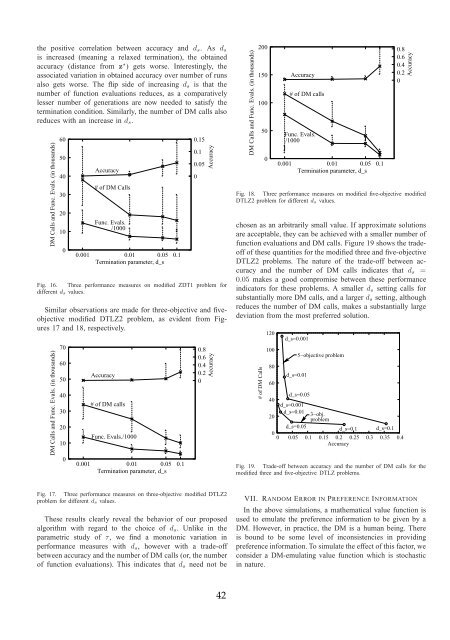Progressively Interactive Evolutionary Multi-Objective Optimization ...
Progressively Interactive Evolutionary Multi-Objective Optimization ...
Progressively Interactive Evolutionary Multi-Objective Optimization ...
You also want an ePaper? Increase the reach of your titles
YUMPU automatically turns print PDFs into web optimized ePapers that Google loves.
the positive correlation between accuracy and ds. As ds<br />
is increased (meaning a relaxed termination), the obtained<br />
accuracy (distance from z ∗ ) gets worse. Interestingly, the<br />
associated variation in obtained accuracy over number of runs<br />
also gets worse. The flip side of increasing ds is that the<br />
number of function evaluations reduces, as a comparatively<br />
lesser number of generations are now needed to satisfy the<br />
termination condition. Similarly, the number of DM calls also<br />
reduces with an increase in ds.<br />
DM Calls and Func. Evals. (in thousands)<br />
60<br />
50<br />
40<br />
30<br />
20<br />
10<br />
0<br />
Accuracy<br />
# of DM Calls<br />
Func. Evals.<br />
/1000<br />
0.001<br />
0.01 0.05 0.1<br />
Termination parameter, d_s<br />
0.15<br />
0.1<br />
0.05<br />
Fig. 16. Three performance measures on modified ZDT1 problem for<br />
different ds values.<br />
Similar observations are made for three-objective and fiveobjective<br />
modified DTLZ2 problem, as evident from Figures<br />
17 and 18, respectively.<br />
DM Calls and Func. Evals. (in thousands)<br />
70<br />
60<br />
50<br />
40<br />
30<br />
20<br />
10<br />
0<br />
Accuracy<br />
# of DM calls<br />
Func. Evals./1000<br />
0.001 0.01 0.05 0.1<br />
Termination parameter, d_s<br />
0<br />
Accuracy<br />
0.8<br />
0.6<br />
0.4<br />
0.2<br />
0<br />
Fig. 17. Three performance measures on three-objective modified DTLZ2<br />
problem for different ds values.<br />
These results clearly reveal the behavior of our proposed<br />
algorithm with regard to the choice of ds. Unlike in the<br />
parametric study of τ, we find a monotonic variation in<br />
performance measures with ds, however with a trade-off<br />
between accuracy and the number of DM calls (or, the number<br />
of function evaluations). This indicates that ds need not be<br />
Accuracy<br />
42<br />
DM Calls and Func. Evals. (in thousands)<br />
200<br />
150<br />
100<br />
50<br />
0<br />
Func. Evals.<br />
/1000<br />
0.001<br />
Accuracy<br />
# of DM calls<br />
0.01 0.05<br />
Termination parameter, d_s<br />
0.1<br />
0.8<br />
0.6<br />
0.4<br />
0.2<br />
0<br />
Fig. 18. Three performance measures on modified five-objective modified<br />
DTLZ2 problem for different ds values.<br />
chosen as an arbitrarily small value. If approximate solutions<br />
are acceptable, they can be achieved with a smaller number of<br />
function evaluations and DM calls. Figure 19 shows the tradeoff<br />
of these quantities for the modified three and five-objective<br />
DTLZ2 problems. The nature of the trade-off between accuracy<br />
and the number of DM calls indicates that ds =<br />
0.05 makes a good compromise between these performance<br />
indicators for these problems. A smaller ds setting calls for<br />
substantially more DM calls, and a larger ds setting, although<br />
reduces the number of DM calls, makes a substantially large<br />
deviation from the most preferred solution.<br />
# of DM Calls<br />
120<br />
100<br />
80<br />
60<br />
d_s=0.001<br />
d_s=0.01<br />
5−objective problem<br />
d_s=0.05<br />
40<br />
20<br />
d_s=0.001<br />
d_s=0.01<br />
3−obj.<br />
problem<br />
0<br />
0<br />
d_s=0.05<br />
0.05 0.1 0.15<br />
d_s=0.1<br />
0.2 0.25<br />
d_s=0.1<br />
0.3 0.35 0.4<br />
Accuracy<br />
Fig. 19. Trade-off between accuracy and the number of DM calls for the<br />
modified three and five-objective DTLZ problems.<br />
Accuracy<br />
VII. RANDOM ERROR IN PREFERENCE INFORMATION<br />
In the above simulations, a mathematical value function is<br />
used to emulate the preference information to be given by a<br />
DM. However, in practice, the DM is a human being. There<br />
is bound to be some level of inconsistencies in providing<br />
preference information. To simulate the effect of this factor, we<br />
consider a DM-emulating value function which is stochastic<br />
in nature.
















